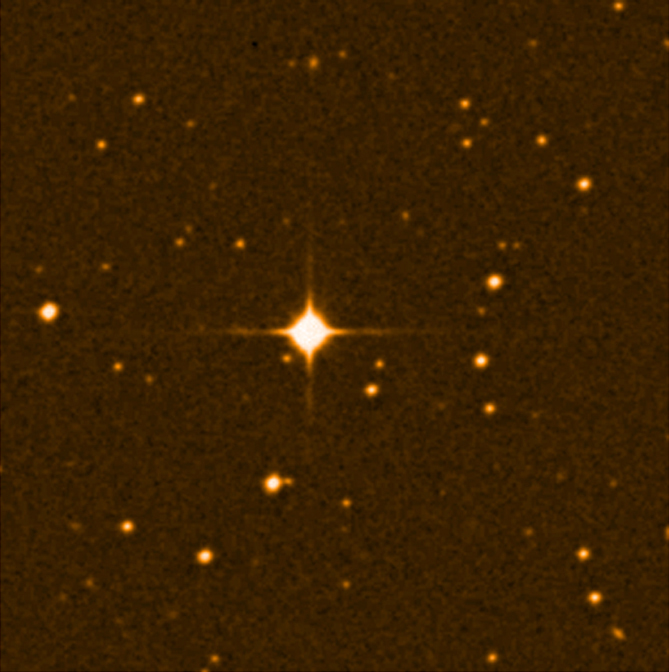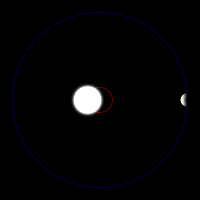A new Earth-like exoplanet
Interview with
Chris - Also in the news this week, astronomers at the University of California, Santa Cruz and also from the Carnegie Institution of Washington have announced the discovery of an Earth-like planet that's outside our own solar system. It's thought that liquid water, as well as an atmosphere, could exist on that planet's surface, which would make it potentially the first habitable exoplanet. And joining us from the University of California, Santa Cruz to tell us more about the discovery is one of the co-authors of the paper, Steven Vogt. He is the Professor of Astronomy and Astrophysics. Hello, Steven.
Steven - Hello, Chris.

Chris - Thank you for joining us on the Naked Scientists. The first question I think probably to kick off with is, where is this planet?
Steven - This is in the constellation of Libra. It's about 20 light years away, so it's one of the nearest stars and it's a pretty exciting star to be looking at.
Chris - What's the name of the star?
Steven - The star is called 'Gliese 581 g.' That's after a catalogue of nearby stars by a man named Gliese basically. So it's number 581 in that catalogue.
Chris - And how did you actually spot the planet or planets because this isn't the first planet that's been spotted around that star?
Steven - That's right. A number of groups have been observing many of the nearby stars for many years. The Swiss group from Geneva has already detected four planets around this system over the last four or five years, using about four years' worth of data. And we've now found two more in the system.
Chris - So talk us through the experimental methods you used because even though something is relatively close, 20 light years, it's still far enough away that conventional telescopes are going to find that tricky. So, how did you do the study?
Steven - The study is done by measuring the velocity of the star. We take a spectrum of the star and measure the shifts - the Doppler shifts of the lines. Every night, we get one data point basically, so we have hundreds of nights of observations on there, and we're basically measuring how the planet tugs on the star. This particular Earth-like planet tugs on the star at a level of about 1 meter a second, so it makes the star sort of stroll back and forth with a period of about 37 days.
Chris - So because the planets in orbits are making the host star wobble a bit, you can pick up that wobble because it makes the light which is coming to us from that star get a bit stretched out or shrunk a bit and we can pick that up. That tells you that there's something pulling on the star, but how do you resolve individual planets because as you've already mentioned, there are a number of planets going around that star?
Steven - That's right. There are six of them now, so each one pulls with its own period and these are strictly periodic Keplerian motions and we fit these out using very sophisticated computer programs, and we strip them out one at a time. With each new planet, once we remove it from the system then we'd look at the residuals and look for periodicity in the residuals, and we work our way down through the system one at a time. So the overall dance that is done with six planets is quite complex, but we have mathematical techniques to follow that.

Chris - So presumably, you have worked out the only possible solution to all these different wobbles is, if you've got a planet which you say is Earth-like, it's in what's called a 'habitable zone' around that star. So, what can you tell about that planet?
Steven - Well, what we know about it is that we know its mass. We know we have a lower and an upper limit to its mass. It's about three to four times as massive as the earth. We know what it's made out of. If it was made out of Styrofoam or marshmallow cream, it would be one temperature and one size. We know it's made out of the sort of stuff that planets are made out of, mostly iron and silicate - things like that. So we have a pretty good estimate of what its radius would be from very detailed models. And that turns out to be about 20 to 50% bigger than the Earth, and spherical. It would be a spherical ball. It wouldn't look like a doughnut or something like that. So now we know its gravity basically. We know its surface gravity and we know how effectively it could hold on to its atmosphere. And it turns out to have about an Earth gravity, maybe a little bit more. So if you stood on a scale on the surface of that planet, you wouldn't be too shocked, your weight would be about the same as you weigh on Earth.
Chris - A relief for many people. What about the conditions on the planet? Can you infer anything about what it would be like if you were to go there?
Steven - Yes. Actually, we know a fair amount about that. We know that the planet is tightly locked to its star, so it keeps one face towards its star all the time. Just the same way that the moon keeps its same face towards the Earth all the time, and that would mean that it would have a hot side and a cold side, and then a whole bunch of temperatures, a range of temperatures in between. So the area between the bright and the darkness, what we called a terminator would be the most comfortable. And much of that would be shirt-sleeve weather. You could just stand outside and there would be mild winds, mild breezes, but it would be temps of basically about 20 to 40 degrees Celsius, so it would be quite cool, quite nice. And presuming that it had an atmosphere, there would probably be liquid water on the surface either in vast quantities or in small quantities. So it'd be quite a pleasant place to be.
Chris - Which is encouraging and just to finish off, given that you found this relatively hospitable sounding place, relatively easily, what does this tell us about the prospects of finding more like it elsewhere in the Milky Way because our own galaxy has got what, two hundred billion stars in it?
Steven - Yes and to me, that's one of the most interesting things to this discovery. It occurred too quickly and too nearby. We shouldn't have found it that soon, and that means one or two things. Either we've been really lucky and we won't find another one again for a long, long time, or there's a lot of them out there. I'd prefer the second hypothesis that there are a lot of them out there, and if you work out the statistics of the numbers from our incompleteness of our surveys, you find that probably 10 to 20% of stars have planets like this. And that means tens of billions of these places in our own galaxy and that's quite exciting.
Chris - Certainly is an intriguing thought. Thank you very much Steven for joining us. Steven Vogt from the University of California, Santa Cruz.









Comments
Add a comment